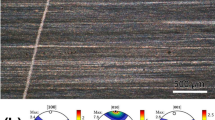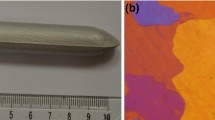Abstract
This work investigates the potential of selected-area electron diffraction (SAED) for the polytype and polymorph identification of finely divided K-bearing aluminous dioctahedral mica. Individual mica crystals may indeed differ by their layer-stacking sequence and by the inner structure of their octahedral sheets (polytypic and polymorphic variants, respectively). This diversity of natural mica is commonly considered to be responsible for their morphological variety. The present article thus analyzes the intensity distribution between hk0 beams as a function of the crystal structure and thickness. The comparison of ED calculations with experimental diffraction data shows that predicted dynamical effects are not observed for finely divided dioctahedral mica. The influence of different structure defects on calculated intensities is analyzed, and their widespread occurrence in natural mica is hypothesized to be responsible for the limitation of dynamical diffraction effects. SAED may thus be used to identify the structure of individual dioctahedral mica crystals using the kinematical approximation to simulate and qualitatively interpret the observed intensities.









Similar content being viewed by others
Notes
Electron Microscopy Suite, Java version (JEMS). http://cimewww.epfl.ch/people/stadelmann/jemswebsite/jems.html.
MacTempas package from Total Resolution LLC. http://www.totalresolution.com/.
References
Amisano-Canesi A, Chiari G, Ferraris G, Ivaldi G, Soboleva SV (1994) Muscovite-3T and phengite-3T–Crystal-structure and conditions of formation. Eur J Mineral 6(4):489–496
Amouric M, Baronnet A (1983) Effect of early nucleation conditions on synthetic muscovite polytypism as seen by high-resolution transmission electron microscopy. Phys Chem Miner 9(3–4):146–159
Amouric M, Baronnet A, Finck C (1978) Polytypisme et désordre dans les micas dioctaédriques synthétiques: étude par imagerie de réseau. Mater Res Bull 13(6):627–634
Amouric M, Mercuriot G, Baronnet A (1981) On computed and observed HRTEM images of perfect mica polytypes. B Mineral 104(2–3):298–313
Bailey SW (1984) Classification and structure of the micas. In: Bailey SW (ed) Micas. Mineralogical Society of America, Chelsea, vol 13, pp 1–12
Bailey SW (1988) Hydrous phyllosilicates (exclusive of micas), vol 19. Reviews in Mineralogy. Mineralogical Society of America, Chelsea
Beermann T, Brockamp O (2005) Structure and analysis of montmorillonite crystallites by convergent-beam electron diffraction. Clay Miner 40(1):1–13
Blin A (2007) Illites: liens entre morphologie et structure–Influence sur la thermodynamique de la nucléation et de la croissance. Dissertation, University of Poitiers, France
Cowley JM (1992) Electron diffraction techniques. In: IUo (ed) Crystallography. IUCr Monographs on crystallography, vol 3. Oxford University Press, Oxford
Cowley JM, Moodie AF (1957) Fourier images: I–The point source. Proc Physic Soc B70(5):486–496
Drits VA (1987) Electron diffraction and high-resolution electron microscopy of mineral structures. Spring, New-York
Drits VA, Sakharov BA (2004) Potential problems in the interpretation of powder X-ray diffraction patterns from fine-dispersed 2M1 and 3T dioctahedral micas. Eur J Mineral 16(1):99–110
Drits VA, Goncharov YI, Aleksandrova VA, Khadzhi VE, Dmitrik AL (1975) New type of strip silicate. Sov Phys Crystallogr 19:737–741 (translated from Kristallografiya, 1974, 19:1186–1193)
Drits VA, Plançon A, Sakharov BA, Besson G, Tsipursky SI, Tchoubar C (1984a) Diffraction effects calculated for structural models of K-saturated montmorillonite containing different types of defects. Clay Miner 19(4):541–562
Drits VA, Tsipursky SI, Plançon A (1984b) Application of the method for the calculation of intensity distribution to electron diffraction structural analysis. Izvestya Akademii Nauk SSSR, Seriya Physic 2:1708–1713 (in Russian)
Drits VA, Weber F, Salyn AL, Tsipursky SI (1993) X-ray identification of one-layer illite varieties: application to the study of illites around uranium deposits of Canada. Clays Clay Miner 41(3):389–398
Drits VA, Lindgreen H, Salyn AL, Ylagan RF, McCarty DK (1998) Semiquantitative determination of trans-vacant and cis-vacant 2:1 layers in illites and illite-smectites by thermal analysis and X-ray diffraction. Am Mineral 83(11–12 (1)):1188–1198
Drits VA, McCarty DK, Zviagina BB (2006) Crystal-chemical factors responsible for the distribution of octahedral cations over trans- and cis-sites in dioctahedral 2:1 layer silicates. Clays Clay Miner 54(2):131–152
Drits VA, Zviagina BB, McCarty DK, Salyn AL (2010) Factors responsible for crystal-chemical variations in the solid solutions from illite to aluminoceladonite and from glauconite to celadonite. Am Mineral 95(2–3):348–361
Durovic S (1992) Layer stacking in general polytypic structures. In: Wilson AJC (ed) International tables for crystallography–C Mathematical, physical and chemical tables, vol C. Kluwer Academic Publisher, Dordrecht, pp 667–680
Emmerich K, Kahr G (2001) The cis- and trans-vacant variety of a montmorillonite: an attempt to create a model smectite. Appl Clay Sci 20(3):119–127
Emmerich K, Madsen FT, Kahr G (1999) Dehydroxylation behavior of heat-treated and steam-treated homoionic cis-vacant montmorillonites. Clays Clay Miner 47(5):591–604
Ewald PP (1917) On the explanation of crystal optics. Annalen Der Physik 54(23):519–556
Gemmi M, Nicolopoulos S (2007) Structure solution with three-dimensional sets of precessed electron diffraction intensities. Ultramicroscopy 107:403–494
Guthrie GD, Reynolds RC (1998) A coherent TEM- and XRD-description of mixed-layer illite/smectite. Can Mineral 36(6):1421–1434
Güven N (1974a) Electron-optical investigations on montmorillonites–I Cheto, Camp-Berteaux and Wyoming montmorillonites. Clays Clay Miner 22(2):155–165
Güven N (1974b) Factors affecting selected area electron diffraction patterns of micas. Clays Clay Miner 22(1):97–106
Humphreys CJ, Bithell EG (1992) Electron diffraction theory. In: Cowley JM (ed) Electron diffraction techniques, vol 3. Oxford University Press, Oxford, pp 75–151
IUCr (1992) International tables for crystallography-C. Mathematical, physical and chemical tables, vol C. International Tables for Crystallography. Kluwer Academic Publisher, Dordrecht
Kameda J, Miyawaki R, Drits VA, Kogure T (2007) Polytype and morphological analyses of Gümbelite, a fibrous Mg-rich illite. Clays Clay Miner 55(5):453–466
Kodama H, Gatineau L, Mering J (1971) Analysis of X-ray diffraction line profiles of microcrystalline muscovites. Clays Clay Miner 19(6):405–413
Kogure T (2002a) Identification of polytypic groups in hydrous phyllosilicates using electron backscattering patterns. Am Mineral 87(11–12):1678–1685
Kogure T (2002b) Investigation of micas using advanced transmission electron microscopy. In: Mottana A, Sassi FP, Thompson JB Jr, Guggenhein S (eds) Micas: crystal chemistry and metamorphic petrology, vol 46. Mineralogical Society of America, Washington, pp 281–310
Kogure T, Drits VA (2010) Structural change in celadonite and cis-vacant illite by electron radiation in TEM. Clays Clay Miner 58(4):522–531
Kogure T, Nespolo M (1999) First occurrence of a stacking sequence including (+60°, 180°) rotations in Mg-rich annite. Clays Clay Miner 47(6):784–792
Kogure T, Kameda J, Drits VA (2008) Stacking faults with 180° layer rotation in celadonite, an Fe- and Mg-rich dioctahedral mica. Clays Clay Miner 56(6):612–621
Lanson B, Champion D (1991) The I/S-to-illite reaction in the late stage diagenesis. Am J Sci 291(5):473–506
Lanson B, Beaufort D, Berger G, Baradat J, Lacharpagne J-C (1996) Illitization of diagenetic kaolinite-to-dickite conversion series: late-stage diagenesis of the Lower Permian Rotliegend Sandstone reservoir, offshore of the Netherlands. J Sediment Res 66(3):501–518
Lanson B, Beaufort D, Berger G, Bauer A, Cassagnabere A, Meunier A (2002) Authigenic kaolin and illitic minerals during burial diagenesis of sandstones: a review. Clay Miner 37(1):1–22
Laverret E, Patrier Mas P, Beaufort D, Kister P, Quirt D, Bruneton P, Clauer N (2006) Mineralogy and geochemistry of the host-rock alterations associated with the Shea Creek unconformity-type uranium deposits (Athabasca Basin, Saskatchewan, Canada). Part 1. Spatial variation of illite properties. Clays Clay Miner 54(2):275–294
Liang JJ, Hawthorne FC, Swainson IP (1998) Triclinic muscovite: X-ray diffraction, neutron diffraction and photo-acoustic FTIR spectroscopy. Can Mineral 36:1017–1027
Meunier A, Velde B (1989) Solid solutions in I/S mixed-layer minerals and illite. Am Mineral 74(9–10):1106–1112
Moeck P, Rouvimov S (2010) Precession electron diffraction and its advantages for structural fingerprinting in the transmission electron microscope. Zeit Krist 225:110–124
Nicolopoulos S, Morniroli J-P, Gemmi M (2007) From powder diffraction to structure resolution of nanocrystals by precession electron diffraction. Zeit Krist Suppl 26:183–188
Patrier P, Beaufort D, Laverret E, Bruneton P (2003) High-grade diagenetic dickite and 2 M(1) illite from the Middle Proterozoic Kombolgie formation (Northern Territory, Australia). Clays Clay Miner 51(1):102–116
Plançon A, Tsipursky SI, Drits VA (1985) Calculation of intensity distribution in the case of oblique texture electron diffraction. J Appl Crystallogr 18:191–196
Srodon J, Elsass F, McHardy WJ, Morgan DJ (1992) Chemistry of illite-smectite inferred from TEM measurements of fundamental particles. Clay Miner 27:137–158
Tsipursky SI, Drits VA (1977) Effectiveness of the electronic method of intensity measurement in structural investigation by electron diffraction. Izv An SSSR Fiz+ 1:2263–2271 (in Russian)
Vainshtein BK (1956) Structural electronography. (English translation) edn. Akademii Nauk SSSR, Moscow (English translation)
Weiss Z, Wiewiora A (1986) Polytypism of micas. III. X-ray diffraction identification. Clays Clay Miner 34(1):53–68
Zviagina BB, Sakharov BA, Drits VA (2007) X-ray diffraction criteria for the identification of trans- and cis-vacant varieties of dioctahedral micas. Clays Clay Miner 55(5):467–480
Zvyagin BB (1967) Electron diffraction analysis of clay mineral structures (Elektronografiya i strukturanaya kristallografiya glinistykh mineralov (1964)). Plenum, New York
Zvyagin BB, Vrublevskaya ZV, Zhoukhlistov AP, Sidorenko OV, Soboleva SV, Fedotov AF (1979) High-voltage electron diffraction in the study of layer minerals. Nauka Press, Moscow
Acknowledgments
This work was supported by a NSF grant #EAR0409071 (ACG, and DRV) and a Lavoisier fellowship (French Ministry of Foreign Affairs) to ACG. VAD thanks the Russian Foundation for Basic Research for financial support. Daniel Beaufort (Hydr’Asa, Poitiers—France) and Roar Kilaas (Total Resolution, Berkeley—USA) are thanked for providing the mica samples and for valuable discussions about the MacTempas software, respectively. Alain Baronnet (CINaM, Marseille—France) and Ken Livi (JHU, Baltimore—USA) are thanked for providing TEM access, assistance, and for fruitful discussions. The present version of the article benefited from the constructive comments of three anonymous reviewers.
Author information
Authors and Affiliations
Corresponding author
Electronic supplementary material
Below is the link to the electronic supplementary material.
Rights and permissions
About this article
Cite this article
Gaillot, AC., Drits, V.A., Veblen, D.R. et al. Polytype and polymorph identification of finely divided aluminous dioctahedral mica individual crystals with SAED. Kinematical and dynamical electron diffraction. Phys Chem Minerals 38, 435–448 (2011). https://doi.org/10.1007/s00269-011-0417-4
Received:
Accepted:
Published:
Issue Date:
DOI: https://doi.org/10.1007/s00269-011-0417-4




